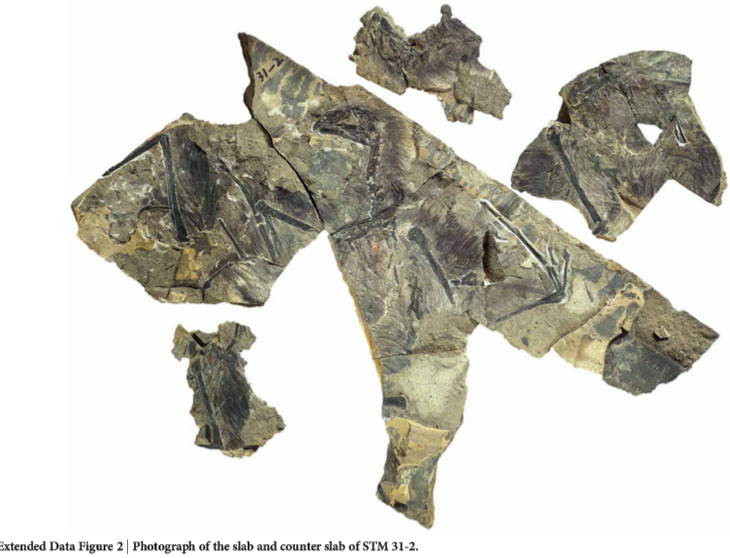Dinobat discovered in China
The new dinosaur, named Yi qi (shown above in the artists reconstruction), had unusual bristle-like feathers and bat-like wings that were covered in a membrane. The dinosaur may have been able to glide and even flap
- A bizarre Jurassic maniraptoran theropod with preserved evidence of membranous wings
- nature.com / A bizarre Jurassic maniraptoran theropod with preserved evidence of membranous wings
- dinobat discovered in China
- theconversation.com / a-bizarre-new-flying-dinosaur-with-bat-like-wings-and-feathers
- Yi qi is thought to have lived 160 million years ago during the late Jurassic
- The dinosaur has an unusual bone sticking out of its wrist and had a membrane that covered it to form a wing much like that of a modern bat
- Scientists say it is unlike any other dinosaur, which evolved into birds, and may have glided or even been able to fly by flapping over short distances
- The fossil was discovered by a farmer in Qinglong County in north China
- Related audio
Kerri Smith talks to palaeontologist Xing Xu and editor Henry Gee about an unexpected find in the dinosaur lineage leading to birds.
 |
The fossil of Yi qi (above) was so well preserved that bristle-like feathers and the remains of its membrane wings could be seen around the bones. The strange long bone extending from the wrist was highly unusual
 |
 |
| The fossil of Yi qi was discovered by a farmer working his fields in Mutoudeng in Qinglong County in China |
A bizarre new dinosaur with bat-like wings has been discovered by a farmer in China and is now helping to shed new light on the evolution of flight.
Palaeontologists in China say the impeccably preserved fossil belongs to a small dinosaur thought to have lived 160 million years ago.
The strange-looking creature had small stiff feathers on its body and long finger-like bones extending from each wrist that were covered in a membrane like a bat’s wing.
Scientists believe the dinosaur, which they have named Yi qi, meaning ‘strange wing’, may have glided or even flown through the air.
video backup
Birds evolved from dinosaurs – but it wasn’t a smooth transition. Plenty of creatures tried different ways to get into the air – like this newly discovered dinosaur species, Yi qi, unearthed in China. This pigeon-sized creature had elongated fingers that held a membrane wing, more like a bat than a bird. In this Nature Video, we look at what makes this fossil so special, and consider what this dinosaur may have looked like.
The discovery has provided new insight into how vertebrates first began to take to the air.
Researchers say the dinosaur, which would have weighted just 13 ounces (380g) and was 33cm (12 inches) long with a wings that spanned 60cm (23 inches), may have been an early evolutionary experiment with flight.
Yi qi belongs the group of carnivorous dinosaurs known as the therapods - which includes Tyranosaurus rex and velociraptor.
These dinosaurs are thought to have been the ancestors of modern birds.
But unlike modern birds, Yi qi was found to have a strange extra bone extending backwards from its wrist, rather like an entirely separate group of animals that learned to fly - the bats.
Professor Xing Xu, one of the world’s leading prolific palaeontologists at the Chinese Academy of Sciences in Beijing and who led the work, said: 'This is really something for me. It is the most unexpected discovery I ever made.
'Birds are descended from dinosaurs, but how exactly the transition occurred is not really clear. This new discovery is a new species of these bird like dinosaurs.
'This dinosaur is totally different. It has totally different wings from all other birds and their close relatives.
'Close to the origin of birds there are many lineages trying to get into the air but there was only one group that succeeded.
'I would have said this example shows how much experimentation close to this transition.'
The discovery comes in the same week as researchers announced the discovery of a bizarre vegetarian relative of the T-Rex.
The Yi qi fossil was discovered by a local farmer in Mutoudeng, in Qinglong County, Hebei Province in China.
The fossil has preserved stiff filamentous features on the forelimb and hindlimb, along with patches of the membrane that once stretched across its wings.
However, it was the strange wrists and long rod-like bones that extended from them that baffled the attention of the palaeontologists.
There are three main groups of flying vertebrates - the birds, which evolved from dinosaurs, pterosaurs that were flying reptiles that existed alongside the dinosarus, and the bats, which are mammals that evolved after the extinction of the dinosaurs 66 million years ago.
Most winged avian dinosaurs to be discovered so far all have wing structures that are similar to those of modern birds.
However, Yi qi, which is pronounced 'ee chee', appears to be a weird hybrid between a dinosaur and a bat.
This suggests that at the time several different types of winged dinosaurs evolved wings in an attempt to fly.
Read more: http://www.dailymail.co.uk/sciencetech/article-3061003/Weird-dinobat-discovered-China-Dinosaur-wings-like-BAT-reveal-clues-origin-flight.html#ixzz3Yv3RyE5m
Follow us: @MailOnline on Twitter | DailyMail on Facebook
'We don’t know if Yi qi was flapping, or gliding, or both, but it definitely evolved a wing that is unique in the context of the transition from dinosaurs to birds.'
It is likely that the conclusions will be controversial with other evolutionary biologists, but it could prove hugely valuable in unravelling how birds evolved from their dinosaur ancestors.
Professor Zheng Xiaoting, from Linyi University in Shandong who also took part in the study, said: 'Yi qi lived in the Jurassic, so it was a pioneer in the evolution of flight on the line to birds.
'It reminds us that the early history of flight was full of innovations, not all of which survived.'
Dr Kevin Padian, a palaeontologist at the University of California Berkeley, warned that the animal may not have been able to fly at all.
He said: ‘As for gliding, if Yi qi’s styliform element helped to support a membranous aerofoil, it can be used to reconstruct the planform of the wing, as Xu and colleagues have done.
‘But in a gliding animal, the centre of lift of the aerofoil should be fairly congruent with the centre of gravity of the body — if the bulk of the animal’s weight falls too far behind the centre of lift, the back end will sag and the animal will stall.
‘That is clearly the case in the authors’ reconstruction of Yi qi, but an aerofoil that was swept back more, if anatomically possible, might have mitigated this problem.
‘Still, we are left in a quandary: an animal with a strange structure that looks as if it could have been used in flight, borne by an animal that otherwise shows no such tendencies.
‘And so far, there is no other plausible explanation for the function of this structure.’
When it comes to big fossil finds, China is full of surprises. The latest dinosaur discovery, announced today in Nature, is a bizarre chicken-sized animal with a delightfully short scientific name, Yi qi, Mandarin for “strange wing” (pronounced “yee chee”).
Yi is a new type of scansoriopterygid, a family of small feathered dinosaurs with unusually long fingers, including forms like Epidexipteryx.
The extensively feathered fossil of Yi hails from the Middle-Late Jurassic (160-165 million years old) of Hebei Province, in northern China. It preserves a rod-like prop extending from the wrist along with patches of bare, featherless tissue around the hands.
The most likely explanation is that the digits and bony rod supported membranous wing like in modern bats or mythical dragons. It is unclear if Yi was capable of powered flight or simply glided.
I [and others] were suspicious that it wasn’t really part of the animal, but instead maybe a plant branch or other object that coincidentally was right under the wrist. But chemical analysis of it shows it really is derived from bone.
Pterosaurs, extinct flying reptiles with a wing membrane supported by a single elongated finger, are not dinosaurs although they lived at the same time. Yi is definitely not a pterosaur due to its skull structure and forelimb anatomy. It is a true dinosaur that seems to have evolved its own unique kind of wing. Holtz adds:
[…] in case anyone thinks otherwise, this [discovery] has zero to do with the origin of pterosaurs!
The first feathered dinosaur known to science was the famous Archaeopteryx, described in 1861 from the Jurassic of Germany although for over a century it was, by convention, called a bird simply because it had feathers.
This view was challenged by the discovery of feathered dinosaurs from Liaoning, China, beginning in 1996 with the announcement of Sinosauropteryx from the Early Cretaceous, about 125 million years old.
Numerous fossils from China, Canada, Germany and Russia prove that many groups of dinosaurs sported feathers or feather-like structures. These ranged from simple hair-like filaments to the complex pennaceous true feathers of modern birds, the latter used primarily for flight.
We found out about this new dinosaur when were both visiting the Institute of Vertebrate Palaeontology and Palaeoanthropology (IVPP) in Beijing. We paid a courtesy call to our colleague Professor Xu Xing.
Excitedly, he showed us his remarkable new find on his computer, as the original specimen was recently returned to the Shandong Tianyu Nature Museum. I asked him why it represents such an important discovery to which he replied:
This is the most unexpected discovery I have ever made, even though I have found a few really bizarre dinosaurs in my career.
Xu has contributed to some of the most spectacular Chinese dinosaur discoveries, from the four-winged Microraptor to the giant feathered tyrannosaur Yutyrannus. Xu continued:
I know the complexity of the dino-bird transition but this new find shocks me. It demonstrates some of the extreme early experimentation as dinosaurs began to take to the air.
When dinosaurs took flight
Yi illustrates that the transition from dinosaur to bird wasn’t as straight forward as previously thought. A great deal of innovation took place in animals close to the origin of birds, ranging from the membranous wings of Yi to the four feathery wings of Microraptor.
Flight evolved multiple times within the dinosaurs. The configuration in modern birds, with a single pair of feathered wings, would ultimately prove to be the winning formula.
One objection against the dinosaurian origin of birds was the supposed absence of feathered dinosaurs in rocks older than Archaeopteryx (the 150 million year old “first bird”). The Daohugou removes this paradox, revealing a community of feathered creatures that lived over 10 million years before Archaeopteryx.
Corwin Sullivan is a Canadian scientist based at IVPP who was involved in the study. He told us:
One of the most exciting things about this animal is the way it seems to have independently hit on a type of flight apparatus, consisting of an aerodynamic membrane supported partly by a rod of bone or cartilage, that is also seen in pterosaurs, bats and many gliding mammals. In that respect Yi really showcases the power of evolutionary convergence.




























COMMENTS